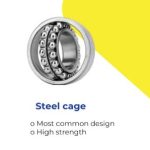Space aeronautics is a diverse field and bearings manufactured for Spacecraft should withstand rigorous conditions of space travel and provide smooth operation of the spacecraft components. Bearing races being the critical component of a spacecraft, it should be designed for longevity and reliability to ensure that missions do not fail. At NEI, after continuous research and development, it has recently developed High Precision Bearings Races for Spacecraft that can empower indigenous organizations to use bearings manufactured in the country itself.
NEI Breaking the Long Legacy of Dependency for Spacecraft Bearings
The Indian organizations working on space aeronautics have to earlier rely on foreign players for manufacturing bearing races for spacecraft but now due to the latest development and research by NEI, the bearing races can be manufactured in the country itself. It will open new avenues for space research in the country and accelerate space missions in the coming years. The industry has greatly appreciated these efforts offering new opportunities for such developments.Reaction Wheels for Spacecraft – How Critical it is in Space Missions
Reaction wheels are a crucial element of spacecraft that controls the altitude and x,y, and z axis of aircraft in space. In short, it deals with changing the orientation of a spacecraft. The bearings and associated components should be designed in a rigorous and reliable manner otherwise it can lead to critical failures. In the past, many mission failures have occurred due to faults in bearings which has resulted in severe losses for space agencies. One such case was the Kepler Telescope in which the bearing wasn’t able to overcome the friction due to which the reaction wheel failed and the mission failed way before its expected completion time.Why High Precision Bearings Races for Spacecraft Needed?
Here are various reasons why bearings need to be high precision in a space environment where there is no scope to perform maintenance:- Offers Low Friction Interface: High precision bearings races for spacecraft are needed to provide a low friction interface between moving parts. This is especially important in environments where there is no atmosphere to provide lubrication, as friction can cause wear and generate heat that can damage sensitive components.
- Reduce Vibrations: Bearings also help to reduce vibration making them an important part of the overall design of a spacecraft. The vibration can also cause fatigue to some of the internal components which can result in part failure.
- Optimal Design: The high-precision bearing races for spacecraft are designed with keeping reliability and rigorous conditions in consideration. They are perfect for high-speed and high-tolerance applications.
- Works in Extreme Weather Conditions in Space: The weather conditions in space are quite different from what we face on earth. The major challenge is coronal mass ejection from the sun which can be hazardous to aircraft. The high precision bearing races can work well in such hazardous conditions too.
- High Running Accuracy: The bearings are designed with a high degree of precision to ensure that they can maintain a high level of running accuracy.
- Reduced wear and tear on bearings: By providing a smooth surface for the bearings to rotate on, high precision bearings races help to reduce wear and tear on the bearings, lengthening their lifespan.
- Improved performance: The smooth, precise surface provided by high-precision bearings races leads to improved performance of the bearings, providing smoother and more efficient operation of the spacecraft.
- Enhanced durability: The increased durability of the bearings provided by high precision bearings races leads to enhanced durability of the spacecraft as a whole, providing longer life and increased reliability in difficult conditions.
- Reduced Heat Generation & Low Noise: The main advantage of using high-precision bearings in spacecraft is that they generate less heat and have low vibration levels. This is important as it helps to prolong the life of the spacecraft by reducing wear and tear and it also ensures that the spacecraft can operate at its highest level of efficiency.



















